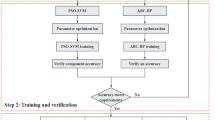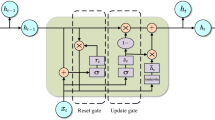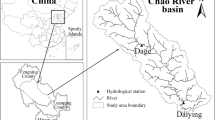Abstract
Precipitation is the most basic part of the water cycle process. Aiming at the problem of low prediction accuracy caused by the nonlinear and unstable characteristics of the precipitation series, a new precipitation prediction method based on the CEEMDAN-IWOA-BP coupling model is proposed. This method first uses the complete ensemble empirical mode decomposition with adaptive noise (CEEMDAN) to decompose the original precipitation sequence, and obtains a series of intrinsic mode function (IMF) and residual terms (Res) as inherent potential influencing factors, innovatively introduce TENT chaotic mapping and roulette algorithm to improve the Whale Optimization Algorithm (WOA), use IMFs and Res as the input of the Improve Whale Optimization Algorithm (IWOA) to optimize Back Propagation (BP) neural network prediction model, and finally superimpose the predicted values as ultima result.The present method was applied to predict the annual precipitation from 1958 to 2017 in Sichuan Province. Compared with the prediction results of other models, the CEEMDAN-IWOA-BP coupled model has significantly improved prediction accuracy than the single model, and the prediction error index is smaller than the BP neural network optimized by the Genetic Algorithm (GA) and Particle Swarm Optimization (PSO) algorithms, moreover, the optimization accuracy and solving ability are significantly enhanced compared with the unimproved WOA. It can extract the information of complex precipitation series more effectively, and then provide a new method for nonlinear and unstable precipitation time series prediction.









Similar content being viewed by others
Availability of Data and Materials
Data and materials are available from the corresponding author upon request.
References
Ahmed M, Gu F, Ball A (2011) Feature selection and fault classification of reciprocating compressors using a genetic algorithm and a probabilistic neural network. J Phys Conf Ser 305(1):012112. IOP Publishing
Balaji TK, Annavarapu CSR, Bablani A (2021) Machine learning algorithms for social media analysis: A survey. Computer Science Review 40:100395
Bennett A, Braumoeller BF (2022) Where the model frequently meets the road: Combining statistical, formal, and case study methods. arXiv preprint arXiv:2202.08062
Bouchaoui L, Ferahtia J, Farfour M, Djarfour N (2022) Vertical electrical sounding data inversion using continuous ant colony optimization algorithm: A case study from Hassi R'Mel, Algeria. Near Surf Geophys
Cao J, Li Z, Li J (2019) Financial time series forecasting model based on CEEMDAN and LSTM. Physica A 519:127–139
Chen S, Hao M, Qian Y, Ding F, Xie X, Ma T (2022) Prediction of global marginal land resources for Pistacia chinensis Bunge by a machine learning method. Sci Rep 12(1):1–9
Dumitru C, Maria V (2013) Advantages and Disadvantages of Using Neural Networks for Predictions. Ovidius Univ Ann Ser Econ Sci 13(1)
Gan Y, Meng B, Chen Y, Sun F (2022) An intelligent measurement method of the resonant frequency of ultrasonic scalpel transducers based on PSO-BP neural network. Measurement 190:110680
Gobashy M, Abdelazeem M, Abdrabou M, Khalil MH (2020a) Estimating model parameters from self-potential anomaly of 2D inclined sheet using whale optimization algorithm: applications to mineral exploration and tracing shear zones. Nat Resour Res 29(1):499–519
Gobashy M, Abdelazeem M, Abdrabou M (2020b) Minerals and ore deposits exploration using meta-heuristic based optimization on magnetic data. Contrib Geophys Geod 50(2):161–199
Huang NE, Shen Z, Long SR, Wu MC, Shih HH, Zheng Q, Liu HH (1998) The empirical mode decomposition and the Hilbert spectrum for nonlinear and non-stationary time series analysis. Proc R Soc London Ser A Math Phys Eng Sci 454(1971):903–995
Hueffel JA, Sperger T, Funes-Ardoiz I, Ward JS, Rissanen K, Schoenebeck F (2021) Accelerated dinuclear palladium catalyst identification through unsupervised machine learning. Science 374(6571):1134–1140
Hutt A, Grüning A, Hansen A, Hartung T, Robeva R (2022) Machine learning in natural complex systems. Front Appl Math Stat
Karijadi I, Chou SY (2022) A hybrid RF-LSTM based on CEEMDAN for improving the accuracy of building energy consumption prediction. Energy Build 259:111908
Liu MD, Ding L, Bai YL (2021a) Application of hybrid model based on empirical mode decomposition, novel recurrent neural networks and the ARIMA to wind speed prediction. Energy Convers Manag 233:113917
Liu Z, Zhu X, Ma J, Hu C, Fu H, Zhao K (2021b) Application of optimization technology for overhaul decision of substation equipment based on machine learning. J Phys Conf Ser 2066(1):012095. IOP Publishing
Lu K, Ma Z (2021) A modified whale optimization algorithm for parameter estimation of software reliability growth models. J Algorithms Comput Technol 15:17483026211034442
Mirjalili S, Lewis A (2016) The whale optimization algorithm. Adv Eng Softw 95:51–67
Moustris KP, Larissi IK, Nastos PT, Paliatsos AG (2011) Precipitation forecast using artificial neural networks in specific regions of Greece. Water Resour Manag 25(8):1979–1993
Musbah H, Aly HH, Little TA (2021) Energy management of hybrid energy system sources based on machine learning classification algorithms. Electric Power Systems Research 199:107436
Pakdaman M, Babaeian I, Javanshiri Z, Falamarzi Y (2022) European multi model ensemble (EMME): A new approach for monthly forecast of precipitation. Water Resour Manag 36(2):611–623
Papacharalampous G, Tyralis H, Koutsoyiannis D (2018) Univariate time series forecasting of temperature and precipitation with a focus on machine learning algorithms: A multiple-case study from Greece. Water Resour Manag 32(15):5207–5239
Putra AS, Srigutomo W, Hidayat Y, Lesmana E (2019) A Comparative Study of Simulated Annealing and Genetic Algorithm Method in Bayesian Framework to the 2D-Gravity Data Inversion. J Phys Conf Ser 1204(1):012079. IOP Publishing
Ravuri S, Lenc K, Willson M, Kangin D, Lam R, Mirowski P, Mohamed S (2021) Skilful precipitation nowcasting using deep generative models of radar. Nature 597(7878):672–677
Rumelhart DE, Hinton GE, Williams RJ (1986) Learning representations by back-propagating errors. Nature 323(6088):533–536
Shen Z, Zhang Q, Singh VP, Pokhrel Y, Li J, Xu CY, Wu W (2022) Drying in the low-latitude Atlantic Ocean contributed to terrestrial water storage depletion across Eurasia. Nat Commun 13(1):1–10
Singh U, Rizwan M, Alaraj M, Alsaidan I (2021) A machine learning-based gradient boosting regression approach for wind power production forecasting: a step towards smart grid environments. Energies 14(16):5196
Tang T, Jiao D, Chen T, Gui G (2022) Medium-and long-term precipitation forecasting method based on data augmentation and machine learning algorithms. IEEE J Sel Top Appl Earth Observ Remote Sens 15:1000–1011
Tolba MF, Sayed WS, Radwan AG, Abd-El-Hafiz SK (2018) Chaos-based hardware speech encryption scheme using modified tent map and bit permutation. In 2018 7th International Conference on Modern Circuits and Systems Technologies (MOCAST). IEEE, pp 1–4
Torres ME, Colominas MA, Schlotthauer G, Flandrin P (2011) A complete ensemble empirical mode decomposition with adaptive noise. In 2011 IEEE International Conference on Acoustics, Speech and Signal Processing (ICASSP). IEEE, pp 4144–4147
Wang L, Bi X (2021) Risk assessment of knowledge fusion in an innovation ecosystem based on a GA-BP neural network. Cogn Syst Res 66:201–210
Wang M, Zhang Z, Yuan Q, Li X, Han S, Lam Y, Lee SC (2022) Slower than expected reduction in annual PM2.5 in Xi'an revealed by machine learning-based meteorological normalization. Sci Total Environ 841:156740
Wu Z, Huang NE (2009) Ensemble empirical mode decomposition: a noise-assisted data analysis method. Adv Adapt Data Anal 1(01):1–41
Xiang X, Ma X, Ma Z, Ma M (2022) Operational carbon change in commercial buildings under the carbon neutral goal: a LASSO–WOA approach. Buildings 12(1):54
Yang BS, Hwang WW, Kim DJ, Tan AC (2005) Condition classification of small reciprocating compressor for refrigerators using artificial neural networks and support vector machines. Mech Syst Signal Process 19(2):371–390
Funding
This research was supported by the Open Fund of the Key Laboratory of Lower Yellow River Channel and Estuary Regulation (LYRCER202101), Key R & D and Promotion Projects in Henan Province (202102310261), Program for Young Backbone Teachers in Universities of Henan Province (2020GGJS093).
Author information
Authors and Affiliations
Contributions
All authors contributed to the study conception and design.
Writing and editing: Fuping Liu and Chen Yang; chart editing: Ying Liu; preliminary data collection: Ruixun Lai. All authors read and approved the final manuscript.
Corresponding author
Ethics declarations
Ethics Approval
Not applicable.
Consent to Participate
Not applicable.
Consent to Publish
Not applicable.
Competing Interests
The authors declare no competing interests.
Additional information
Publisher's Note
Springer Nature remains neutral with regard to jurisdictional claims in published maps and institutional affiliations.
Rights and permissions
Springer Nature or its licensor holds exclusive rights to this article under a publishing agreement with the author(s) or other rightsholder(s); author self-archiving of the accepted manuscript version of this article is solely governed by the terms of such publishing agreement and applicable law.
About this article
Cite this article
Liu, F., Liu, Y., Yang, C. et al. A New Precipitation Prediction Method Based on CEEMDAN-IWOA-BP Coupling. Water Resour Manage 36, 4785–4797 (2022). https://doi.org/10.1007/s11269-022-03277-z
Received:
Accepted:
Published:
Issue Date:
DOI: https://doi.org/10.1007/s11269-022-03277-z




